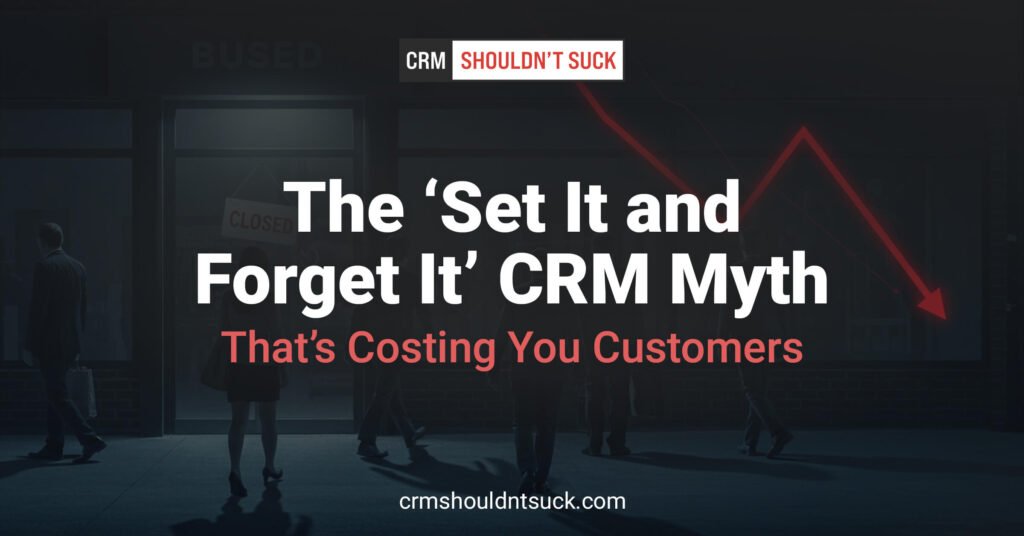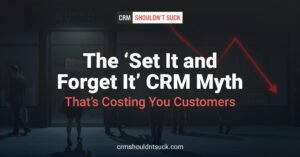The Costly Illusion of ‘Set It and Forget It’
Many businesses invest in a CRM thinking it will magically solve all their customer relationship challenges the moment it’s implemented. They assume that once the system is live, customer interactions will be streamlined, sales will accelerate, and reporting will become effortless. Unfortunately, this mindset leads to one of the most common CRM pitfalls: believing that the job is done after go-live.
A CRM is not a one-time project. It is a living system that requires continuous refinement, adoption, and strategic alignment. Companies that fail to engage with their CRM beyond the initial setup often find themselves struggling with declining adoption rates, incomplete data, and missed revenue opportunities.
Why ‘Set It and Forget It’ Fails
Lack of User Adoption
One of the earliest signs of a neglected CRM is when sales teams and other users start bypassing the system. If data entry is cumbersome, if the CRM doesn’t integrate well with daily workflows, or if leadership isn’t consistently using it for forecasting and decision-making, it quickly becomes an afterthought. A CRM that is not actively used provides little value.
Stagnant Data Equals Bad Decisions
Data quality degrades rapidly in an unmaintained CRM. Duplicate records, outdated contact information, and incomplete customer profiles all lead to poor decision-making. When leadership relies on inaccurate or incomplete data, forecasting becomes unreliable, sales efforts become misdirected, and customer relationships suffer.
Missed Opportunities for Optimization
Every business evolves. Customer needs shift, sales processes change, and new market dynamics emerge. A CRM that isn’t regularly evaluated and optimized will fail to keep up. Automation rules become outdated, workflows no longer reflect current business needs, and integrations with other systems may become inefficient. Without continuous assessment, the CRM quickly loses its ability to drive value.
Disconnect Between Leadership and Sales
If sales leadership is not actively using the CRM to review pipeline data, track key metrics, and inform strategy, frontline teams won’t see a reason to keep data accurate. When leaders make decisions based on gut instinct rather than CRM insights, the system loses credibility and relevance.
Keeping Your CRM Relevant and Effective
Commit to Continuous Improvement
A CRM should be viewed as an evolving tool. Regular reviews of user adoption, workflow effectiveness, and system performance should be conducted. Are reports delivering the insights needed? Are sales teams engaged with the system? Are customers experiencing smoother interactions as a result of CRM-driven automation? A CRM audit every quarter can identify areas where improvements are needed.
Invest in Training and Reinforcement
User engagement drops when employees are not properly trained or when new hires are expected to “figure it out” on their own. CRM training should be ongoing, not a one-time event. Every new feature rollout, process update, or integration should come with clear guidance and hands-on support.
Keep Data Quality a Priority
Implement data governance policies to ensure that customer records remain accurate and useful. Set clear expectations for data entry and maintenance, automate de-duplication and validation processes where possible, and regularly clean up outdated records.
Integrate CRM with Broader Business Goals
A CRM is most valuable when it is tightly aligned with an organization’s strategic objectives. Leadership should use CRM data for decision-making, track key performance indicators within the system, and ensure that processes are continually refined to support broader company goals. Sales, marketing, and customer service teams should all see the CRM as an enabler, not a burden.
Build a Culture of CRM Ownership
Successful CRM adoption comes from the top down. When leadership actively uses and promotes the system, teams follow suit. Recognizing employees who maintain clean data, leverage CRM insights, and contribute to improving workflows can reinforce its importance.
The Bottom Line
A CRM is not a plug-and-play solution. It requires commitment, adaptation, and continuous refinement to deliver real value. Businesses that treat their CRM as a dynamic, evolving tool will see improved sales performance, better customer relationships, and more accurate business insights. Those that assume ‘set it and forget it’ is a viable strategy will find themselves dealing with wasted investments and lost revenue.



